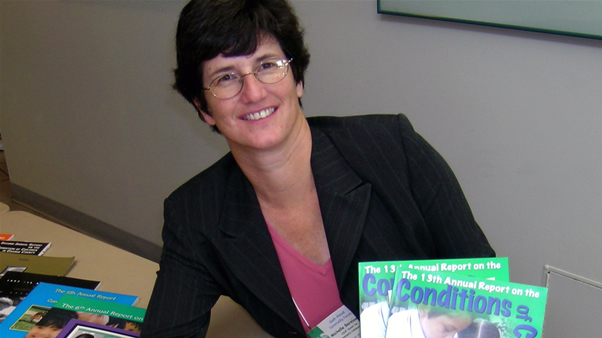How OC Youth Fare
Annual Forum Reveals Health, Housing and Well-Being Issues
October 29, 2007
By Mimi Ko Cruz
More children are living in poverty and gang membership has spiked for youngsters, ages 8 to 17, according to the 13th Annual Report on the Conditions of Children in Orange County.
The report, filled with statistics on the health, economic status, safety and education of Orange County’s children, was discussed at an Oct. 29 forum on campus. More than 400 educators, community leaders, human service group members, law enforcement and probation officers participated.
Agencies throughout the county use the report, which is produced by Cal State Fullerton’s Center for Community Collaboration, to help them determine what can be done to improve the lives of children.
“The community continues to look at the report as a gauge to benchmark progress,” said Michelle Berelowitz, center director.
The report includes a special section on Orange County’s homeless, which was addressed at the forum by Scott Darrell, executive director of the Kennedy Commission in Orange County. The commission is an advocacy organization that supports affordable housing developments and works on providing housing for the poor.
“Orange County is a very expensive place to be poor,” Darrell said. “Seventy percent of Orange County’s homeless are working families with children.... Home pricing is high — rents continue to rise. We’re simply not providing enough affordable housing.”
Darrell said that 40 percent of all families nationwide can afford a home, but, in Orange County, only 10 percent are able to do so.
“We know what the solution is — we need affordable homes,” Darrell said, adding that the philanthropic community, as well as private corporations, must support plans to increase affordable housing throughout the county so the poor can live in areas where they work.
Clayton Chau, associate medical director of integrated services and
recovery for the Orange County’s Health Care Agency, said homeless
children suffer myriad ways.
Homeless children are more likely to suffer from more illnesses, perform
poorly in school, exhibit behavior problems and tend to have low self-esteem,
he said.
Once homeless himself, Chau said the effects on children can be devastating.
“Whatever the reason, it doesn’t matter,” Chau said. “Our children should not have to be homeless. How can this happen in America? If we have one homeless child, that’s one child too many.”
A former homeless family, once separated because the parents were drug
addicts, told their story of rehabilitation, how they recovered and were
reunited via help from various government, nonprofit and educational
agencies throughout the county.
This year’s report contains data that provides an analysis of trends
over the past decade. Some of the conditions that need improvement, Berelowitz
said, include:
* The number of students who qualify for and receive free or reduced-priced lunches at school increased by 9.1 percent (169,528 children) between the 1997-98 school year and the 2006-07 school year (184,956 children).
* In 2006, there were 1,205 known gang members, ages 8 to 17. That’s 375 more gang member than there were in 2002.
* Between 1996 and 2005, the percentage of newborns with low birth weight increased from 5.2 to 6.3 percent.
The report also reveals conditions that have improved. Here are a few:
* The number of women receiving early prenatal care has increased.
* In 2005, there were 97,425 -- a 20 percent decrease from 1997 -- active child support cases in Orange County. The decrease in caseload, coupled with an increase in distributed collections, has led to an increase in per case collections from $807 in 1997 to $1,823 in 2005.
* The Academic Performance Index (API) in Orange County schools’ has increased in the past eight years. The average API scores across all Orange County school districts ranged from 654 to 887 for the 2005-06 school year. Orange County performs above statewide totals of the percent of schools at or above the 800 target.
“There are lots of improvements, but the issue of poverty is important to address since it affects the entire community,” Berelowitz said. “It correlates to low reading scores, a higher level of free and reduced-cost lunches in the schools, low academic performance, crime and homelessness.”
For more information or a copy of the report, call the Center for Community Collaboration at 657-278-5681 or send email to Berelowitz at mberelowitz@fullerton.edu.



